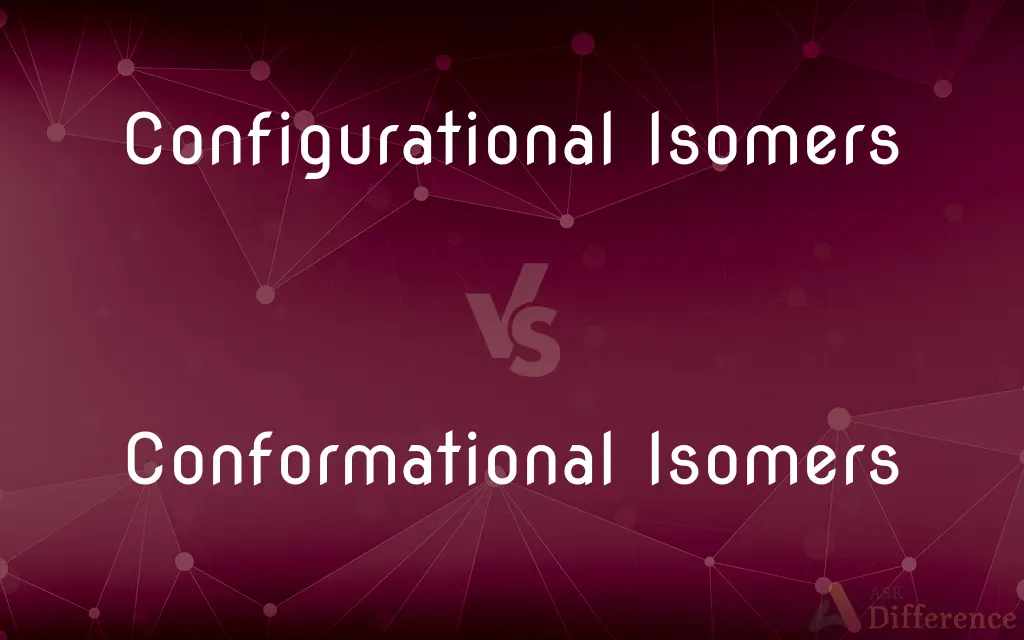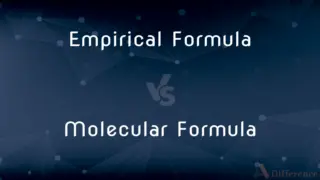Configurational Isomers vs. Conformational Isomers — What's the Difference?
Edited by Tayyaba Rehman — By Fiza Rafique — Published on December 11, 2023
Configurational Isomers have different connectivity of atoms, requiring bond breaking for interconversion, while Conformational Isomers differ only in the rotation around single bonds.

Difference Between Configurational Isomers and Conformational Isomers
Table of Contents
ADVERTISEMENT
Key Differences
Configurational Isomers and Conformational Isomers are both forms of stereoisomers, which are molecules with the same molecular formula but different spatial orientations. However, the nature of their differences varies. Configurational Isomers cannot be interconverted without breaking a covalent bond. For instance, cis-trans isomers in alkenes are Configurational Isomers because changing from one form to another involves breaking and reforming a pi bond. On the other hand, Conformational Isomers arise from the rotation about single bonds, typically visualized using Newman projections. These isomers can easily interconvert at room temperature. For example, the staggered and eclipsed forms of ethane are Conformational Isomers.
Understanding the flexibility of molecules is crucial in organic chemistry. While Conformational Isomers display this flexibility, showcasing different spatial arrangements of atoms achieved by rotating around a single bond, Configurational Isomers are more rigid. The reason lies in their structure; for a molecule to change from one Configurational isomer to another, a bond must be broken and reformed. This characteristic makes them distinct entities with individual properties. Conversely, Conformational Isomers can effortlessly shift from one form to another by mere rotations about single bonds, without any bond breaking, often existing in equilibrium in a solution.
The study of these isomers assists chemists in comprehending molecules' behaviors. Configurational Isomers might exhibit entirely different chemical properties due to their distinct connectivity, making them almost like separate compounds. Conformational Isomers, despite their ease of interconversion, can have varied stabilities; for example, the staggered form of ethane is more stable than its eclipsed form due to fewer steric repulsions.
In advanced studies, particularly in drug development, understanding both Configurational and Conformational Isomers is pivotal. The way a drug molecule fits into its target often depends on its precise shape or configuration. While Configurational Isomers might differ drastically in their biological activity, even subtle shifts in Conformational Isomers can impact a drug molecule's effectiveness.
Comparison Chart
Nature of Difference
Different connectivity of atoms.
Different spatial arrangements due to rotation around single bonds.
ADVERTISEMENT
Bond Breaking for Interconversion
Requires bond breaking.
Doesn't require bond breaking.
Stability
Individual Configurational Isomers are stable and distinct.
They exist in equilibrium and can easily interconvert.
Chemical Properties
Can have drastically different chemical properties.
Typically have similar chemical properties, though stabilities might differ.
Examples
Cis-trans isomers in alkenes.
Staggered and eclipsed forms of ethane.
Compare with Definitions
Configurational Isomers
Stereoisomers that can't interconvert without breaking a bond.
E and Z isomers in alkenes are Configurational Isomers due to the position of substituents.
Conformational Isomers
Isomers that differ due to rotation around a single bond.
Ethane has Conformational Isomers in its staggered and eclipsed forms.
Configurational Isomers
Compounds that have the same atoms but differ in the arrangement of covalent bonds.
Optical isomers which rotate plane-polarized light differently are Configurational Isomers.
Conformational Isomers
Molecules with the same connectivity but different spatial orientations due to bond rotation.
Butane exhibits Conformational Isomers when its methyl groups are anti or gauche to each other.
Configurational Isomers
Isomers that differ in the connection between atoms.
Cis and trans isomers of 2-butene are examples of Configurational Isomers.
Conformational Isomers
Temporary isomers that result from bond rotation.
The different spatial arrangements of a freely rotating alkane bond produce Conformational Isomers.
Configurational Isomers
Molecules with the same molecular formula but different structural connectivity.
L and D forms of amino acids are Configurational Isomers.
Conformational Isomers
Stereoisomers interconvertible without breaking any bonds.
The chair and boat forms of cyclohexane are Conformational Isomers.
Configurational Isomers
Isomers that result from differing spatial arrangements of atoms.
Molecules with different R and S configurations are Configurational Isomers.
Conformational Isomers
Spatial arrangements of a molecule that can change by rotation about single bonds.
Newman projections often depict Conformational Isomers of alkanes.
Common Curiosities
Are Conformational Isomers permanent forms?
No, Conformational Isomers can easily interconvert, often at room temperature.
Can the rotation around double bonds lead to Conformational Isomers?
No, rotation around double bonds is restricted; they lead to Configurational Isomers instead.
Can you provide an example of a Conformational Isomer?
The staggered and eclipsed forms of ethane are Conformational Isomers.
Are enantiomers considered Configurational or Conformational Isomers?
Enantiomers are a type of Configurational Isomer.
What role does bond breaking play in Conformational Isomers?
Bond breaking isn't involved in the interconversion of Conformational Isomers.
Are geometric isomers the same as Conformational Isomers?
No, geometric isomers are Configurational Isomers.
How can I visualize Conformational Isomers?
Newman projections are a common way to visualize Conformational Isomers.
Why don't Conformational Isomers usually have different physical properties?
Because they can rapidly interconvert, often existing in equilibrium.
Do Configurational Isomers have the same molecular formula?
Yes, Configurational Isomers have the same molecular formula but different spatial or connectivity arrangements.
Can Configurational Isomers interconvert without breaking a bond?
No, Configurational Isomers require bond breaking for interconversion.
Which type of isomer might have different chemical properties?
Configurational Isomers might have drastically different chemical properties.
Can a molecule exhibit both Configurational and Conformational Isomerism?
Yes, a molecule can have different configurations (Configurational Isomers) and also different conformations (Conformational Isomers).
What determines the stability of a Conformational Isomer?
Factors like steric hindrance and torsional strain influence the stability of Conformational Isomers.
Is the difference between R and S configurations a matter of Configuration or Conformation?
It's a matter of Configuration; R and S configurations are Configurational Isomers.
Can I interconvert between Conformational Isomers by heating a compound?
Often, yes. Heating increases molecular motion, aiding the interconversion of Conformational Isomers.
Share Your Discovery

Previous Comparison
Alchemy vs. Magic
Next Comparison
Empirical Formula vs. Molecular FormulaAuthor Spotlight
Written by
Fiza RafiqueFiza Rafique is a skilled content writer at AskDifference.com, where she meticulously refines and enhances written pieces. Drawing from her vast editorial expertise, Fiza ensures clarity, accuracy, and precision in every article. Passionate about language, she continually seeks to elevate the quality of content for readers worldwide.
Edited by
Tayyaba RehmanTayyaba Rehman is a distinguished writer, currently serving as a primary contributor to askdifference.com. As a researcher in semantics and etymology, Tayyaba's passion for the complexity of languages and their distinctions has found a perfect home on the platform. Tayyaba delves into the intricacies of language, distinguishing between commonly confused words and phrases, thereby providing clarity for readers worldwide.
















































